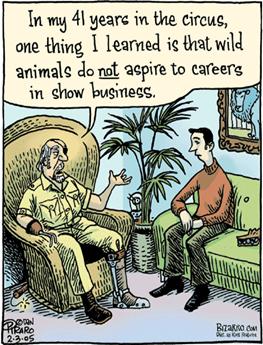
At first glance, the circus environment might appear to be fun and exciting for an animal. Upon closer inspection, one realizes the harsh training methods that circus animals endure and the despicable conditions in which they are forced to live everyday of their lives. Physical Abuse - Regardless of whether these animals are stolen from the wild or born in captivity, they are wild and exotic animals that need severe training to learn how to perform unnatural “tricks”. Training methods involve muzzles, bull hooks, whips, chains and are only successful when the animals spirit is broken. Confinement - Circus animals are forced to travel and perform 50 weeks out of every year. They travel in undersized, barren cages with floors encrusted with feces and urine; they are often fed poor quality feed; provided with little or inadequate veterinary care; and observed exhibiting bizarre, often self-destructive, behaviors. The barest of essentials are often not provided for these animals. Please check out www.circuses.com for more information on charges laid against various animal circuses. |
|||
 |
|||
False Education - The circus is rationalized in many minds by citing the educational value for the children. Perhaps this is the only or first time a child will ever see an elephant, tiger, lion or kangaroo. However, seeing a misrepresentation of animal behavior does not in any way benefit the inquisitive and caring child. The benefits that a child receives from watching a half hour animal act does not outweigh the harm of diminishing the quality of life for a wild and exotic animal. Children who attend the circus are seeing unnatural behaviors exhibited by animals in artificial environments under constant stress. They are learning that it is acceptable to demean animals and laugh at their antics. They are learning nothing about their natural environment, conservation, or of the true dangers these animals pose to public safety. Threat to Public Safety - Since 1990, 50 people (children and adults) have been killed by rampaging, captive elephants, 70 big cats have been killed for “control” reasons, and there have been 46 human deaths and 150 human injuries from big cat attacks. There is very little protection to the circus spectator if a big cat or elephant were to “get out of control”. NS Municipal Bylaws - It is because of the threat to public safety, horrible living conditions and cruel training methods of animals, and the lack of educational value that many municipalities have banned wild and exotic animal acts, entirely. In N.S. for example, Argyle, Bridgewater, Digby, Shelburne and Yarmouth have all enacted bylaws banning the use of wild and exotic animal acts. NS Standards - In 1999, provincial standards for exhibiting circus animals in Nova Scotia were adopted. These are the first and only such standards in Canada. Circuses may not hold primate, bear, piniped, cetacean, amphibian or fish species, and must adhere to specified standards for other species. These standards, however, are rarely enforced and still do not solve the basic problem of confining animals and forcing them to perform against their will. ASAP, with the support of the Nova Scotia Humane Society, is pushing for the Provincial Government to enact a province-wide ban on circuses with wild or exotic animals, the first in Canada. We are currently circulating a petition to submit to the Provincial government. If you would like to add your voice in support of a Provincial ban on wild and exotic animal acts, please contact ASAP, your local MLA, or the Minister of Natural Resources and Agriculture, John MacDonnell. |
|||
|
|||